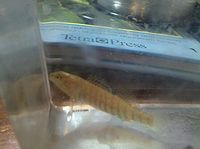Difference between revisions of "Etheostoma zonale"
From The Aquarium Wiki
m |
|||
| Line 36: | Line 36: | ||
|max_water_hardness=12 | |max_water_hardness=12 | ||
}} | }} | ||
| − | + | ||
| − | + | == Origin == | |
| − | + | :Found in riffles and runs of streams in North America. | |
| − | + | ||
| − | + | ||
| − | + | == Sexing == | |
| − | + | :Males are much more colourful, and will have blue stripes instead of brown. Sexing is much easier when fish are in breeding form. | |
| + | |||
| + | |||
| + | == Diet == | ||
| + | :Since the majority of these specimens are wild caught is a good idea to feed them live food, as many will not learn to accept prepared food. | ||
| + | |||
| + | |||
| + | == Environment specifics == | ||
| + | :Found in clear fast moving streams, so a tank should mimic this, they prefer others of their species as tank mates. | ||
| + | |||
| + | |||
| + | == Behaviour == | ||
| + | :Often sits on the bottom of the tank when housed alone. | ||
| + | |||
| + | |||
{{Categories | {{Categories | ||
|Category=Fish, Fish (Freshwater), Oddballs | |Category=Fish, Fish (Freshwater), Oddballs | ||
Latest revision as of 03:25, 13 December 2017
Banded Darter
Etheostoma zonale
57 Litres (15 US G.)
5.1-7.6cm (2-3 ")
Freshwater
6.5 - 7.5
15.6-23.3°C (60 -74 °F)
5-12 °d
1:2 M:F
1-2 years
Family
Percidae
| You can contribute to the Aquarium Wiki by expanding this article. Dont be shy!. |
Contents
Additional names
- Banded Darter
Additional scientific names
- Poecilichthys zonalis
Origin[edit]
- Found in riffles and runs of streams in North America.
Sexing[edit]
- Males are much more colourful, and will have blue stripes instead of brown. Sexing is much easier when fish are in breeding form.
Diet[edit]
- Since the majority of these specimens are wild caught is a good idea to feed them live food, as many will not learn to accept prepared food.
Environment specifics[edit]
- Found in clear fast moving streams, so a tank should mimic this, they prefer others of their species as tank mates.
Behaviour[edit]
- Often sits on the bottom of the tank when housed alone.
Pictures[edit]
External links[edit]
- Fishbase (Mirrors:
 )
)
